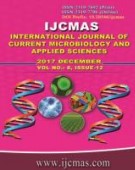


 National Academy of Agricultural Sciences (NAAS)
National Academy of Agricultural Sciences (NAAS)

|
PRINT ISSN : 2319-7692
Online ISSN : 2319-7706 Issues : 12 per year Publisher : Excellent Publishers Email : editorijcmas@gmail.com / submit@ijcmas.com Editor-in-chief: Dr.M.Prakash Index Copernicus ICV 2018: 95.39 NAAS RATING 2020: 5.38 |
A field study was conducted with maize during monsoon season to quantify the response of maize to short-term sequential stresses related to floods and drought. A simulation analysis was also carried out using the InfoCrop maize model. The treatments of irrigated, rainfed, drought and four different combinations of sequential stresses (rainfed, irrigation and drought) at different phases of crop growth were imposed. Silking delayed by about one week under adequate irrigation regime, as compared to that of rainfed crop, however moderate drought advanced silking by 10 days. Grain yield was highest at the irrigated condition. Imposition of sequential stresses RF-D-EW, D-RF-EW, EW-RF-D, D-EW-RF and MD resulted in 46.7%, 51.7%, 35%, 40% and 63.3% decreased in grain yield respectively over irrigated condition. The total biomass was decreased with RF-D-EW, D-RF-EW, EW-RF-D, D-EW-RF and MD by 34.7%, 38.3%, 14.9%, 29.1% and 36.9% respectively. Maize model simulated days to 50% silking well in all situations of multiple stresses except in case where rainfed crop was exposed to excess water/flooding during flowering and then to terminal drought. The total dry matter and yield were also simulated satisfactorily in most of the cases. The InfoCrop maize model worked satisfactorily for rainfed and irrigated conditions and could be calibrated for the experiemental conditions. However, refinement is needed from experimentation and model point of view for simulating the multiple and sequential stress situations.
 |
 |
 |
 |
 |